
Original Link: https://www.anandtech.com/show/1991
First Look: AM2 DDR2 vs. 939 DDR Performance
by Wesley Fink on April 17, 2006 12:05 AM EST- Posted in
- CPUs
AM2 Memory Performance
The move by AMD from the current Socket 939 to Socket AM2 is pretty straightforward. We know the new AM2 processors will continue to be built using the same 90nm manufacturing process currently used for Athlon 64 processors; AMD does not show roadmaps with AM2 processors built on 65nm until early 2007. To this point AMD has also reiterated that AM2 will not bring any changes to the Athlon 64 core. In other words, the socket will change to the new AM2 Socket 940, but under the hood the current 939 and the upcoming AM2 940 will beat with the same heart. The only substantive difference expected with AM2 is the move from DDR memory to official AMD DDR2 Memory support.
With that in mind it is time to delve more deeply into the what is really new in AM2 - support for DDR2 memory with AMD's unique on-processor memory controller. Many have expressed expectations of remarkable performance increases for DDR2 on AM2. This would be at odds with what we have seen from DDR2 in the past. With the move of Intel's NetBurst architecture to DDR2 there were really no gains at all in memory performance. Those expecting big gains point out that the AM2 on-chip memory controller, like the Athlon 64 on-chip DDR controller, should provide much lower latency and higher efficiency than Intel's chipset-based memory controller for DDR2.
This is our first opportunity to look more closely at an AM2 DDR2 controller that might answer these questions about memory performance, since it is the first AM2 design to outperform Socket 939. Earlier AM2 spins could not match 939 memory performance, but they continued to improve. This is remarkable when you consider that new Intel processors pretty much have performed like final shipping processors some 5 months ahead of launch. AMD, on the other hand, has done most of their development work on the DDR2 memory controller in the last 3 months with just 6 weeks remaining before launch.
The most recent AM2 roadmap is still showing AM2 launching June 6, 2006 at Computex in Taipei. With just 6 weeks to go before launch, there is not a lot of time for surprises with AM2. As pointed out in AMD Socket-AM2 Performance Preview, there is not much wiggle room when OEMs expect mid-May shipments of AM2. All of this leads us to believe that our fourth spin of AM2 this year is very close to what will actually be shipping on June 6th. We can always hope for surprises, but given what AMD has said so far we should be very close to final silicon.
You already know that the AM2 does modestly outperform Athlon64 Socket 939. What will be explored here is how the memory controllers compare in latency and bandwidth, memory performance at various DDR2 settings compared to fast DDR400 2-2-2 memory, and basic overclocking performance of AM2 compared to Socket 939 when the CPU and memory are both pushed to improve performance.
Memory Test Configuration
When the article on AM2 processor performance was published a few days ago, the highest performance that could be reached with stability was DDR2-800 at 4-5-4 timings. A new BIOS will now allow the OCZ PC2-8000 reviewed in OCZ EL PC2-8000 XTC: Low Latency PLUS DDR2-1100 to run at 3-3-3 timings in AM2 prototype motherboards. This matches the highest performance achieved with this memory at DDR2-800 on the Intel 975x platform and allows a better comparison to fast DDR-400 memory on the AMD Socket 939 platform.
Pictures of the motherboards used for testing and/or photos of the AM2 processors tested might compromise our product sources, so there will be no pictures with this article. We can tell you that we now have several AM2 motherboards of very recent chipset updates along with several earlier boards that perform at a lower level. We are also testing our 4th spin of AM2, released days ago, and we have also seen increased performance with each spin of the AM2 CPU.
The design of the test bed is to assure, as much as possible, that the only difference between 939 and AM2 test systems is in the memory subsystems. This includes using the latest FX-60 X2 processor with the most recent DDR memory controller adjusted to the same speed as the AM2 X2 processor. Both motherboards are also based on similar NVIDIA chipsets, and all testing was done with the same Hitachi 200GB hard drive using the same OS installation. The MSI 7800GTX video card was used for testing in both systems. We also had NVIDIA 7900GTX and ATI X1900XT video cards available for testing, but we used the 7800GTX for easier comparison to results from other recent motherboard and memory reviews.
| System Configuration | |
| Processor: | AMD AM2 X2 AMD FX-60 (X2) adjusted to match AM2 processor speed |
| RAM: | OCZ EL PC2-8000 XTC (DDR2-1000, 2x1GB) Crucial CLIII5N.32 PN56278 (DDR-500, 2x1GB) |
| Hard Drives: | Hitachi 200GB SATA2 |
| Video Card: | MSI 7800GTX 256MB |
| Video Drivers: | NVIDIA ForceWare 84.21 |
| Power Supply: | OCZ PowerStream 520W |
| Operating System: | Windows XP Professional SP2 |
| Motherboard: | Pre-Release AM2 motherboard based on NVIDIA chipset Asus A8N32-SLI Deluxe |
While the speeds of top DDR and DDR2 are different, we tried to match other factors within memory as much possible. Both DDR and DDR2 were 2 GB kits consisting of 2x1GB dimms. DDR was top-line DDR500 tested at the fastest DDR400 2-2-2 timings; DDR2 was top-line DDR2-1000 tested at the fastest DDR2-800 3-3-3 timings. DDR memory that performs at DDR400 2-2-2 is a premium part and it was compared to a premium DDR2 part.
A more mainstream comparison would have been DDR400 3-3-3 to a DDR2-667 4-4-4 pushed to DDR2-800. The performance differences in the mainstream parts would have been similar, but they would not really reflect the state of the memory market in about 6 weeks. We know that all the top memory vendors plan new DDR2-800 high performance and mainstream parts for the AM2 launch, and offerings at the top of mainstream and high-end will be different in a few weeks. The OCZ PC2-8000 we used for testing, however, is a just-launched DDR2 memory based on what is widely expected to be the best performing DDR2 memory chips available for the near future. This top to top comparison should therefore provide a clear approximation of real performance when AM2 launches.
There is always room for some unexpected AMD announcements, but as Anand explained in his article about the April spin of AM2: ". . . according to internal AMD documents, AM2 CPUs are going to start being sold to distributors starting next month, leaving very little time for significant changes to the CPU to impact performance. We feel that now is as good of a time to preview AM2 performance and put things into perspective as we're likely to get before the official launch." We all can hope for a surprise from AMD, but with distributors receiving parts in less than a month and with official launch just 6 weeks away, we are probably testing what is very close (if not identical) to the final AM2 part.
Socket 939 Fast DDR-400 vs. AM2 Fast DDR-2
DDR has a somewhat narrow operating range. Mainstream DDR might extend from DDR400 to perhaps DDR433. The very best, and most expensive, DDR might extend from DDR400 to a bit over DDR600. The useful range of fast DDR is even less because as the timings increase for higher speed the bandwidth starts to fall. Therefore top bandwidth with many of the top DDR products peaks somewhere in the DDR500 to DDR550 range and bandwidth normally drops as we move higher in frequency at poorer timings.
While ratios can be used with lower performing memory, the main purpose of ratios is to offset the performance limitations of cheaper memory so the user can enjoy the increased performance of overclocked processor without having to similarly invest in expensive memory capable of 1:1 memory overclocking. The point is that we will not be investigating memory ratios on DDR memory, since they are not generally used to increase memory bandwidth and performance.
DDR2 is a different animal when it comes to ratios. As DDR2 matured, memory makers and processor manufacturers have sanctioned higher and higher speed grades of DDR2 that are achieved with memory ratios. Users select and use higher rated DDR2 products to increase memory performance. On the Intel platform there was theoretically a price to pay since the memory controller was on the chipset.. This meant 1:1 DDR2 memory is theoretically top performance without compromise, while other speeds had some degrading from maximum performance due to the overhead of the FSB ratios.
AMD uses HyperTransport, which means there is no FSB. All memory speeds should theoretically perform as if they were 1:1 on HT. This simply means additional DDR2 speeds should carry no penalty at all. A user can choose DDR2-400, DDR2-533, DDR2-667, DDR2-800, DDR2-1066, and other DDR2 speeds based on performance needs and their budget, as there is no one speed which is best in a HyperTransport design.
For all of these reasons, performance of AM2 was benchmarked at DDR2-400, DDR2-533, DDR2-667, and DDR2-800. Due to limitations of current AM2 motherboards in that no timings faster than 3 are available for memory, all 4 speeds were evaluated at 3-3-3 memory timings. This is a fast memory timing for DDR2 at any of those speeds, as the fastest DDR timings we have tested at lower DDR2 speeds is 3-2-2. At DDR2-800, 3-3-3 are the fastest timings ever tested at this speed.
In addition, performance at DDR2-800 3-3-3, the fastest stock speed we could set on current AM2 boards with this memory, was compared to DDR performance at DDR400 2-2-2, which is generally the fastest stock speed on current Socket 939 motherboards. The performance difference is reported in %.
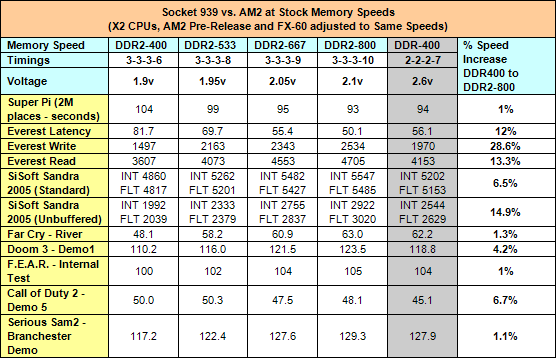
Benchmark results were very interesting. From a broad perspective, memory bandwidth and latency of DDR400 was matched by DDR2 at a speed of just over DDR2-533. Put another way, DDR2-533 provides equivalent bandwidth and latency to DDR400 on this 4th spin of AM2. DDR2-667 provided a bit better performance, and DDR2-800 3-3-3 provided a 12% improvement (lower number) in Latency over DDR400 and a 13.3% to 28.6% improvement in bandwidth depending on the memory benchmark used. It is interesting that memory writes enjoyed the biggest bandwidth boost.
Unfortunately, the added memory bandwidth did not translate into the kinds of increases in real-world gaming performance that many might expect. Gaming Performance at DDR2-800 3-3-3 at the same CPU speed increased 1% to 6.7% in our tests - with all except Call of Duty 2 in the 1% to 4% range. Call of Duty 1.2 was used in these tests, which supports dual processors, and test results did not follow the same expected scaling of other benchmarks. For this reason, the Call of Duty 2 results are considered suspect until we have more experience with Revision 1.2.
Since increased memory bandwidth did not translate into similar increases in gaming performance we can only conclude that this iteration of AM2 is not particularly memory starved - a result that was really expected. This does open the door for future upgrades and revisions of AM2 that might make better use of the available memory bandwidth with fast DDR2 memory.
Comparing Memory Performance
When comparing many results, it is sometimes easier to see relative positioning of test results visually in a graph instead of interpreting numbers in a table. The full range of memory speeds were compared, first in Memory Benchmarks and Super Pi Calculation Performance
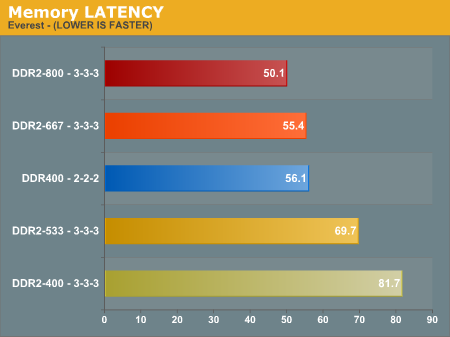
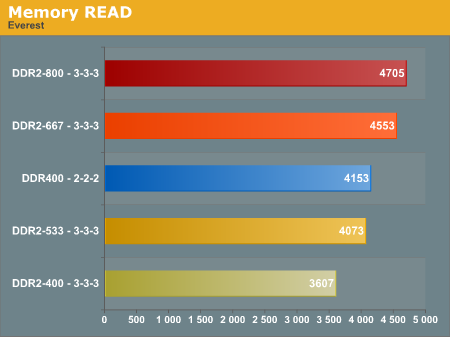
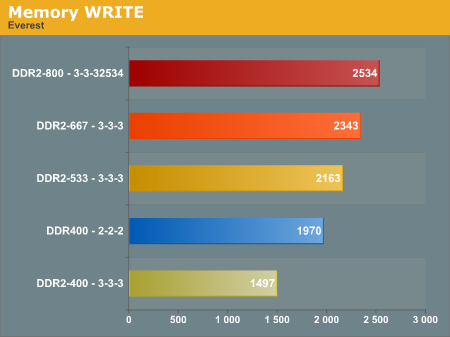

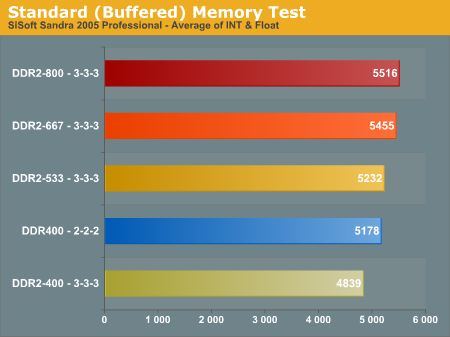
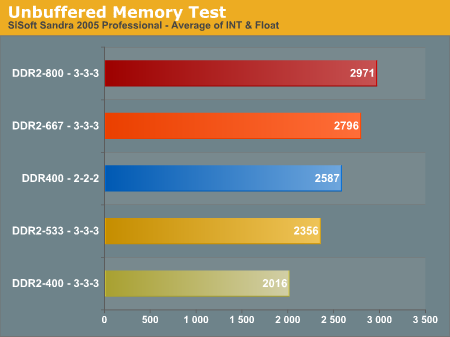
Synthetic Memory benchmarks show DDR400 latency and bandwidth roughly comparable to DDR2-533 3-3-3 performance in our tests. DDR2-667 3-3-3 is a bit higher, with best performance on this 4th spin of AM2 at DDR2-800 3-3-3.
The AM2 memory controller is finally meeting the promise of DDR2 with a dedicated on-processor memory controller. Latency is faster than DDR on AMD and quite a bit faster than latency on the Intel DDR2 memory controller in the motherboard chipset. Efficiency still lags considerably with a top Everest Read+Write Bandwidth of 7.2GB/s compared to a theoretical max of 12.8. This compares to the DDR400 Everest bandwidth that is close to the theoretical maximum of 6.4. As already said, this opens the door for further improvements in DDR2 memory performance as AM2 matures and shrinks to 65nm, more cores, and larger caches.
Comparing Gaming Performance
Real-world gaming results were then compared in charts at all tested memory speeds. Despite the lower memory bandwidth, DDR400 performs better compared to DDR2-800 than we really expected. This will likely shift to patterns similar to those seen in bandwidth positioning as the AM2 memory controller is further refined and game patches make better use of AM2 capabilities.

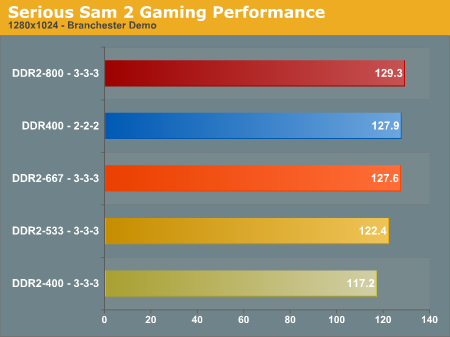
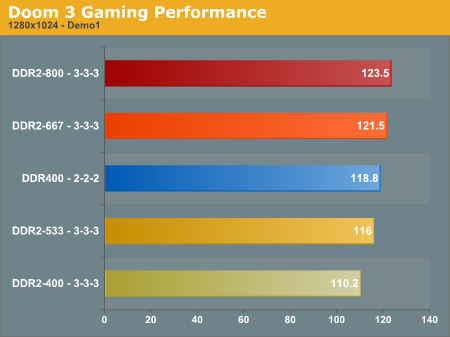
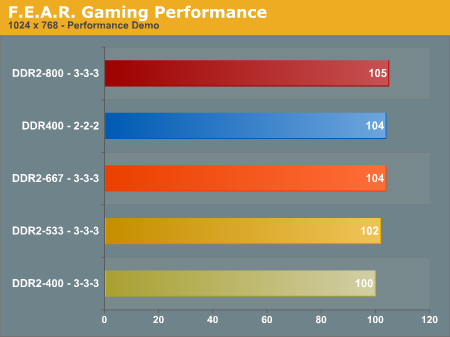

With the exception of Call of Duty 2, DDR2-800 takes the top spot, followed closely by DDR-400 and DDR2-667. (The COD2 issue may be related to the latest 1.2 patch with SMP support; we're looking into the matter more.) What is somewhat surprising is how poorly DDR2-400 does on some of the other tests like Far Cry, where even DDR2-533 is 21% faster. Again, this may simply be last-minute timing issues which will be corrected in the near future, but we don't recommend that anyone run with slower than DDR2-533 on AM2.
AM2 Overclocking vs. Socket 939 Overclocking
Comments are often made that any evaluation of AM2 should include overclocking. Those theorists argue that the faster processor clock will move AM2 to the higher "bus" speeds that make for better efficiencies of the DDR2 memory controller - or something along those lines. With the current state of pre-release motherboards and AM2 processors, it just isn't possible to design a test that runs the AM2 at the 666 processor clock as we would like - the hardware is just not there yet. However, we were able to overclock the CPU almost 40% and finally settled on a workable overclock of the AM2, 939, OCZ DDR2-1000, and Crucial Ballistix DDR500.
The DDR2 memory was perfectly stable at a 250x10 processor setting with a DDR2-667 strap. This results (5:3 ratio) in a DDR2-833 memory speed at 3-3-3-10 timings on an equivalent 2.5GHz x2 AM2 CPU. Similarly the Crucial Ballistix was able to run with stability at 250x10 on a downclocked FX60 x2. With 1:1 ratio this resulted in memory at DDR500 3-3-3-7 timings.
The DDR results are in the general ball park of overclocking that would yield the best bandwidth, as is the AM2 overclocking. Both test setups are running at speeds an Enthusiast might run on an overclock with air. We are thus comparing a fast DDR overclock to a fast DDR2 overclock, within each architecture's capability. We are also running the same memory timings, though the DDR2-800 is running at a faster, but typical, speed for DDR2 on the upcoming AM2 and Conroe processors.
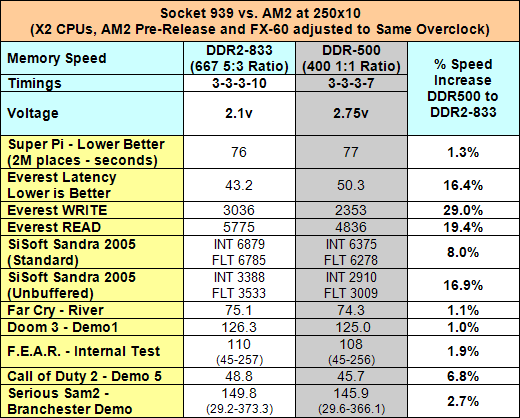
The overclocked test results are very interesting. Comparing DDR500 3-3-3 to DDR2-833 3-3-3 reveals an even greater improvement in latency and bandwidth for the DDR2 than we saw comparing DDR2-800 3-3-3 to DDR400 2-2-2. This is really an unexpected result. DDR2-800 latency is now down to 43.2 and Everest bandwidth increases to 8.8GB/s. DDR2 bandwidth is now 8% to 29% better than the similarly overclocked DDR setup compared to a range of 6.5% to 28.6% on the stock testing. The biggest improvement in the overclocking is Reads, which increase 29% overclocked compared to a 13.3% improvement at stock.
You might expect with an even greater improvement in memory bandwidth, in particular READ speeds, and Latency that a similar improvement in gaming performance would occur. Unfortunately that does not happen, as gaming performance improvements are even less than our stock comparisons. Once again, higher memory bandwidth and lower latency of DDR2 on AM2 just do not translate into markedly improved gaming performance.
Hopefully, this last series of overclocked performance comparisons will finally put into perspective what is and is not possible with improved DDR2 memory performance. Clearly AM2 will launch a bit faster than current Socket 939 performance when comparing the same processor speed. However it is not likely that further increases in DDR2 bandwidth or latency will translate into further improvements in performance with the current AMD/Athlon64 architecture. Further improvements in AM2 performance will have to come with revisions to the core, more cores, die-shrinks and higher speeds, and increases in cache. The move to DDR2 will bring small improvements in performance, but DDR2 alone is not likely to bring the large performance boosts many hope for.
Comparing Overclocked Memory Performance
Results were much clearer in comparing Overclocked Memory Performance when stock performance at DDR400 2-2-2 and DDR2-800 3-3-3 are included for comparison. It is interesting that in Sandra Unbuffered Memory and Everest Latency stock DDR2-800 actually outperforms a heavily overclocked DDR500 3-3-3 running at a much higher CPU speed that results from the overclock.
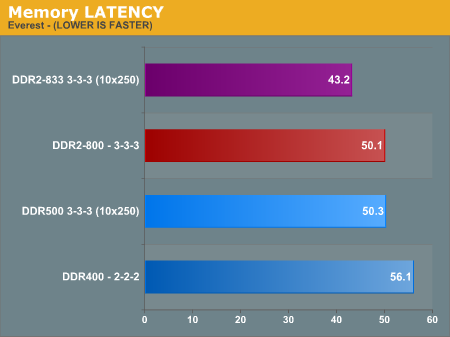
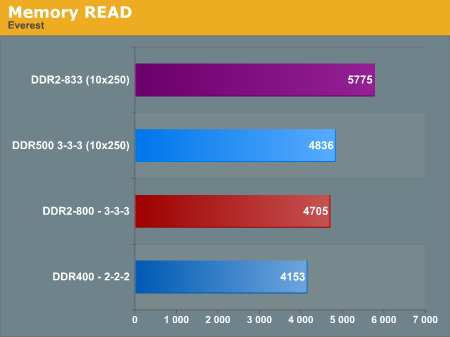
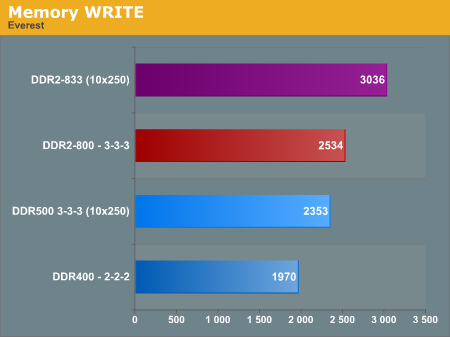
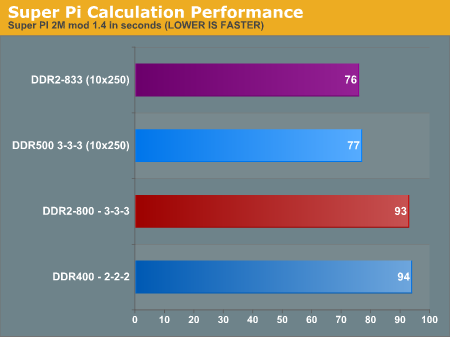
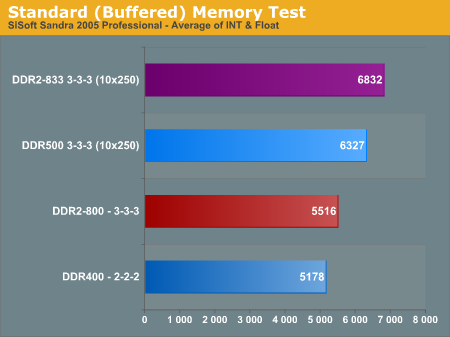
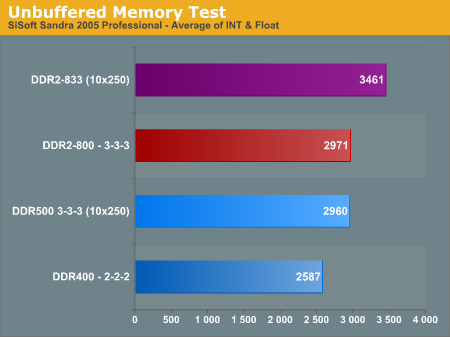
Comparing Overclocked Gaming Performance
We've also compared Real-world gaming results at the overclocked 10x250 processor speed at DDR2-833 3-3-3 memory speed and DDR500 3-3-3 memory speed. As in the overclocked memory comparisons, stock DDR400 2-2-2 and stock DDR2-800 3-3-3 gaming performance are included for a better comparison. The benchmark results are particularly interesting when you consider that the two overclocked results represent a 25% processor speed increase over the stock performance results. The massive increases in memory bandwidth and the significant latency reduction in overclocking still do not have much impact on real-world gaming performance. Results are certainly improved, but they are not 25% higher as you might expect with this kind of overclock.
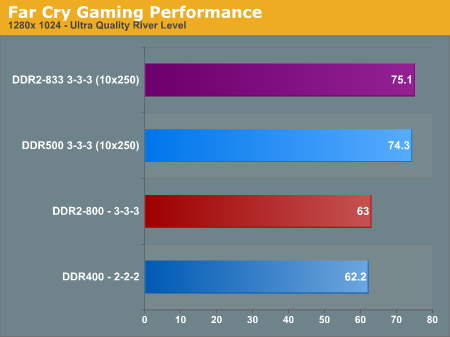

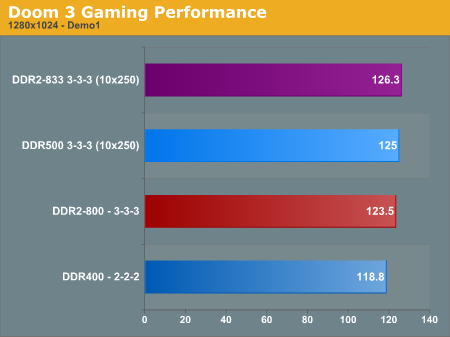
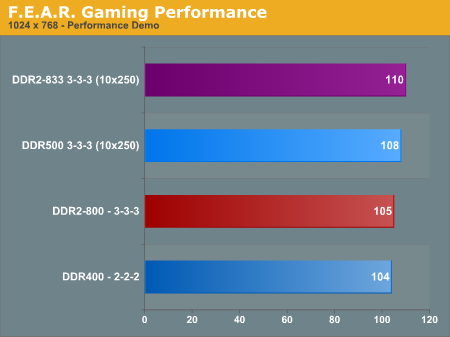
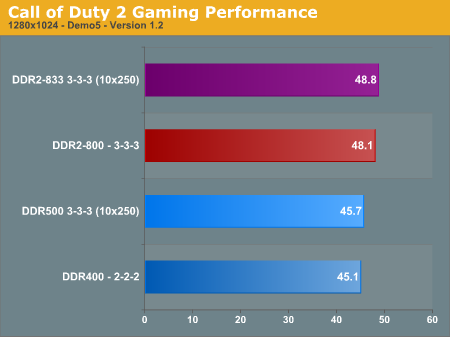
Final Words
When the article OCZ EL PC2-8000 XTC: Low Latency PLUS DDR2-1100 was posted a couple of weeks ago, the potential of this incredibly fast DDR2 memory on the upcoming AM2 platform was clear. What was not expected was that the opportunity to run the DDR2-1000 memory through its paces on an AM2 was only a couple of weeks away. After looking more closely at DDR2 memory performance on the 4th spin of the AM2 processor it is clear AMD will definitely be able to launch AM2 with the expectation of better performance than the Socket 939 it replaces. This avoids one of the huge pratfalls that plagued Intel in their move to DDR2.
However, the memory bandwidth increases of up to 30% on AM2 and the Latency improvements of 12 to 16% compared to the fastest DDR memory on socket 939 do not yield much in real-world performance. The real-world performance increase for AM2 compared to Socket 939 will likely be very small - in the range of no increase to about 7%, depending on the application.
In normal times this would be great news! In times where previews of Intel's new Conroe architecture show solid 20%+ improvements in performance compared to AMD Socket 939, these smaller AM2 increases are reason for concern. It certainly appears that unless some unforeseen miracle happens, the move from Socket 939 DDR to AM2 DDR2 just can't generate anywhere near the performance improvement AMD really needs to combat Intel's Conroe. This article evaluated memory and gaming performance, but you can see comparisons of General Performance, multimedia and encoding in the companion article AMD Socket-AM2 Performance Preview.
Not all is gloom in the AMD camp, however, as there are certainly bright spots. AM2 IS faster than Socket 939, with even more possible DDR2 bandwidth for the future. Unfortunately, unless AMD makes revisions to the core and/or adds more cache with the 65nm die-shrink there is not much improvement from the move to AM2. The extra bandwidth and lower latency just don't translate into meaningful performance improvements with today's applications.
There are also a few general observations about using DDR2 with the new upcoming AM2. Using fast, top-line memory DDR2-533 is roughly equivalent in bandwidth to fast DDR400 memory. That observation should also hold with mainstream memory where DDR400 3-3-3 should perform about like DDR2-533 4-4-4. Most memory manufacturers will also be producing fast high-end DDR2-800 and more mainstream DDR2-667 and DDR2-800 parts for launch with AM2, so there will likely be many more memory choices when AM2 launches.
Last, the move to a unified memory specification with Intel will likely be a good development for those looking to buy new DDR2 memory. With AMD and Intel both using DDR2 there will likely be more innovation in the DDR2 market, more choices, and even better prices. Add to that the expectation that both AM2 and Conroe will launch with official DDR2-800 support and faster DDR2 memory should be much easier to find and afford in the near future.
It appears AMD will succeed in launching a faster on-processor DDR2 memory controller. The latest AM2 pre-release samples are showing significant improvements over Socket 939 DDR in both memory bandwidth and latency. Unfortunately, the current AMD architecture running current applications and games doesn't appear to need the additional bandwidth or reduced latency. This may change in the future, but for now the move to AM2 and DDR2 memory looks like it will yield far too little in performance improvements to keep AMD competitive in the upcoming desktop marketplace.







